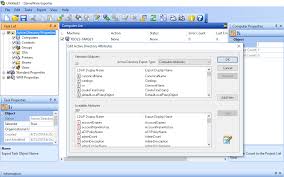
Optimize Active Directory Management with Advanced Toolkits
Active Directory (AD) is a Microsoft service that manages the identities and authorization of end users and computers inside an organization. It retailers all critical info, such as user information details, organizational units, and team insurance policies. Taking out user information from AD is probably the crucial activities of the administrator. However, moving through AD can be tough. However, you will find a solution that makes user information extraction simple – AD user export. In the following paragraphs, we will deal with ways to extract AD user details quickly.
1. Windows Powershell
One of the simplest and a lot popular strategies to draw out user info from AD is via Home windows Powershell. Powershell is actually a order-line device that administrators use to systemize duties and handle configuration. The AD element in Powershell makes removing user information an easy procedure. To remove user details, you have to wide open Powershell as being an administrator and enter in the control ‘Get-ADUser -Filtering * -Attributes * | Export-Csv ‘C:ADUserExport.csv’.’ Once you strike enter, Powershell will get the user info and save it in shine-compatible CSV structure.
2. CSVDE
An alternate way to draw out ad user import data is through CSVDE – a control-line tool that comes with House windows Web server that allows administrators to export AD user data into a CSV file format file. This resource is uncomplicated to utilize, as all it takes is opening up a control quick and entering in the order ‘csvde -f C:ADUserExport.csv -d “DC=Website,DC=org” -r “(objectCategory=user)” -l “cn, givenName, sn, email, sAMAccountName”.’ The control syntax will result user information inside a CSV submit that you can use with any computer software that works with CSV.
3. LDIFDE
LDIFDE is an additional demand-collection instrument that managers use to draw out user details from AD. It exports user data in LDIF structure, an internet common formatting employed to represent LDAP directory articles. The syntax for utilizing this instrument is quite complicated, however, you will be able to quickly draw out user details should you refer to the instructions properly. The demand lines are ‘ldifde -f C:ADUserExport.ldf -d “DC=Domain name,DC=org” -r “(objectCategory=user)” -l “cn, givenName, sn, postal mail, sAMAccountName”.’ This demand will extract user details and conserve it in an LDIF data file structure.
4. Quest Active Directory PowerShell Element
The Mission Active Directory PowerShell unit is yet another well-known AD user export solution. This module runs AD’s functionality by adding numerous cmdlets that can make extracting user information simple and easy uncomplicated. To use this device, you need to download the Journey Active Directory PowerShell unit and install it on your own hosting server. As soon as set up, you can extract user data by keying in inside the demand ‘Get-QADUser | Export-Csv “C:ADUserExport.csv”.’ This control will get user information and save it in CSV formatting.
5. ADManager As well as
ADManager Additionally is a highly effective internet-centered instrument that helps reduce the task than it managers in handling end users, computer systems, and connections in AD. This device gives an easy-to-use website graphical user interface to extract user data from AD. Managers can pick which attributes they wish to get, utilize filter systems, and generate custom reviews. With ADManager In addition, extracting user data is an inconvenience-free method, and managers don’t want to use Powershell or order-series tools any longer.
Summary:
Extracting AD user data could be a overwhelming job for managers, but it’s crucial in controlling and applying AD. The good news is, there are numerous tools and methods offered to streamline AD user extraction. House windows Powershell, CSVDE, LDIFDE, Pursuit Active Directory PowerShell element, and ADManager As well as are typical outstanding options to get AD user data. Choose the technique that matches your needs and make user information removal a hassle-cost-free process.